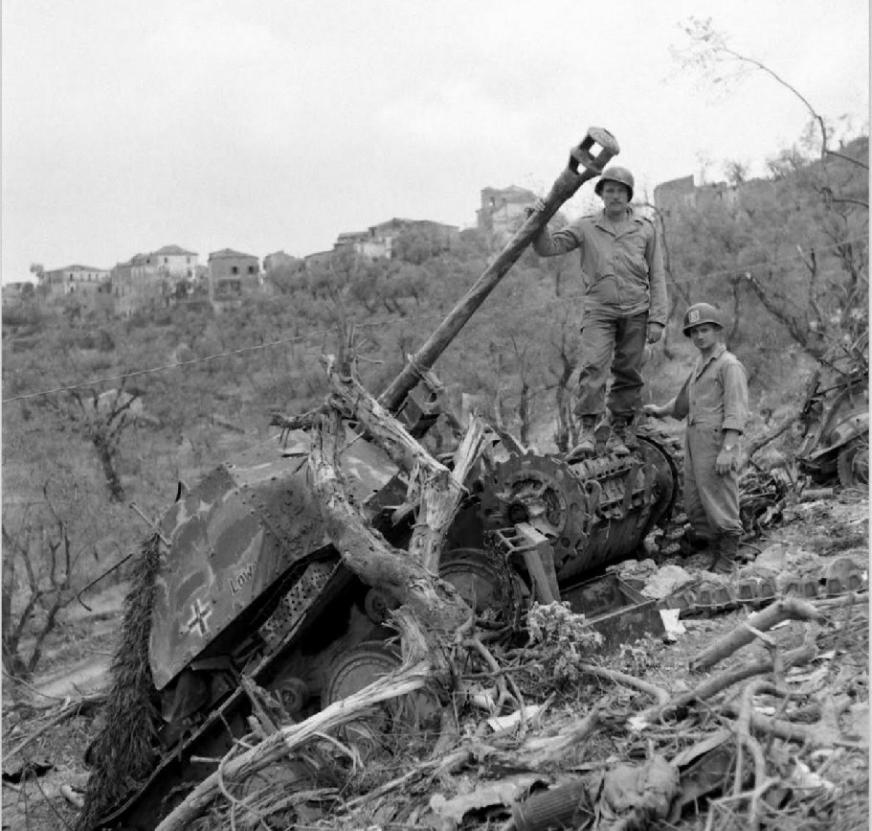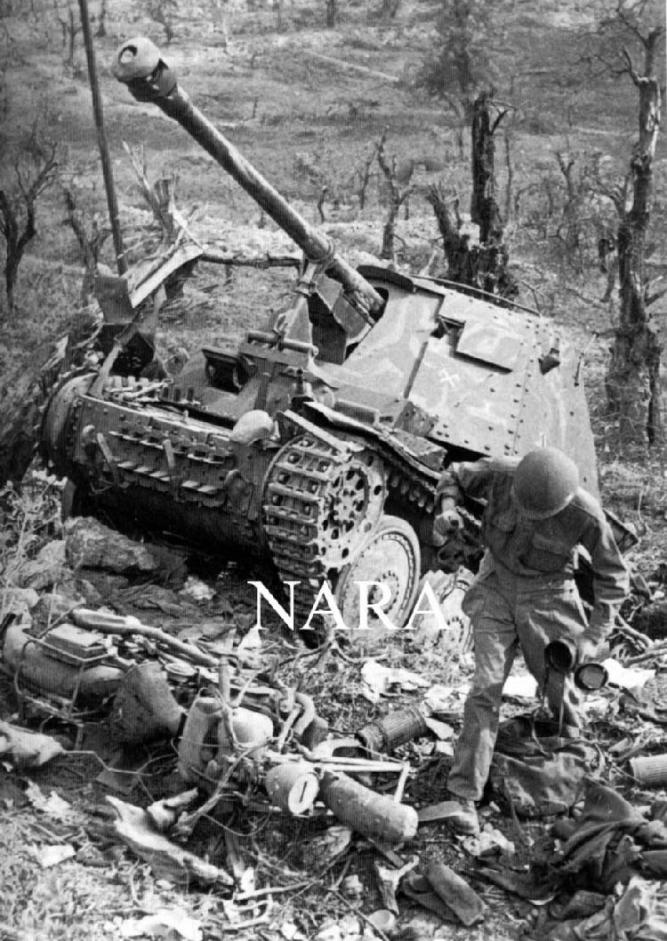

| The summit above Esperia is home to a Middle-Age Monastery, which is now in ruins, above left photo. This area was occupied by the German Army during WWII and was used as an observation point for the western control of the "Gustav Line". QuestMaster "Jonny Reb" Ray is pointing eastward toward Monte Cassino, above right photo. This photo illustrates how well this mountain top controlled much of the movement in the Lire Valley. |


| QuestMasters Museum conducting archeology work within the ruins, above left photo. Several U.S. .30-06 caliber fired projectiles were found in the soft-face of the Monastery slopes, as well as a vintage Coca-Cola bottle and a WWII German 5-liter gas can. Additionally, on the road leading to the summit, a German WWII gas mask carrier, a German WWII 5cm 3-round mortar carrier and a WWI German 8cm "Trench Art" shell casing were found. The southern tower of the Monastery, above right photo. The tower is in relatively good condition considering the fighting conducted around it. |

| THE BATTLE OF ESPERIA, ITALY MAY 17th 1944 |
| An original color photograph, by LIFE Magazine, showing Allied Soldiers inspecting a destroyed heavily camouflaged German Marder III Ausf. H Self-Propelled Gun, of the 71st Infantry Division, 1st Company, Panzer Jager Abteilung 171 (1./Pz.Jg.Abt.171). A destroyed Italian Moto Guzzi ALCE 500 motorcycle, pressed into Wehrmacht service and painted in ordnance tan, lays on its left side, in the right foreground of the photo. Esperia Italy, May 1944, above photo. Photo from LIFE Magazine. Photo analysis above conducted by QuestMasters Museum, January 2018. |

| An original Signal Corps photograph, MM-5-44-5464, dated May 21st 1944, taken just left of the previous photo (the destroyed Marder III would be to the right of this photo), showing Allied Soldier inspecting a destroyed overturned German Raupenschlepper Ost (RSO) Artillery Tractor. Immediately next to the RSO is a German 7,5cm PAK 40 Anti-Tank Gun. In the background is a burned German Zundapp KS750 motorcycle with sidecar and an Italian Carro Armato M15/42 Tank, pressed into Wehrmacht service, which has been completely destroyed and lays on its left side. Esperia Italy, May 21st 1944, above photo. Photo from The National WWII Museum, New Orleans Louisiana. Photo analysis above conducted by QuestMasters Museum, January 2018. |

| Another photo from this series, Signal Corps photograph MM-5-44-5463, shows another view of the destroyed heavily camouflaged German Marder III Ausf. H Self-Propelled Gun, of the 71st Infantry Division, 1st Company, Panzer Jager Abteilung 171 (1./Pz.Jg.Abt.171), being inspected by French Soldiers of the Algerian Division. The door to the Raupenschlepper Ost (RSO) Artillery Tractor, shown in the next photo, lays on the ground to the left of the German Marder III. Esperia Italy, May 18th 1944, above photo. Photo from The National WWII Museum, New Orleans Louisiana. Photo analysis above conducted by QuestMasters Museum, January 2018. |

| Another photo from this series, Signal Corps photograph MM-5-44-5493, shows another view of the destroyed heavily camouflaged German Marder III Ausf. H Self-Propelled Gun, of the 71st Infantry Division, 1st Company, Panzer Jager Abteilung 171 (1./Pz.Jg.Abt.171). A destroyed Italian Moto Guzzi ALCE 500 motorcycle, pressed into Wehrmacht service and painted in ordnance tan, now lays on its right side in the left foreground of the photo with several German gas masks. This motorcycle in previous photos has now been flipped over by curious Allied Soldiers. On the road, to the above left, is an American produced Willys MB or Ford GPW 1/4 Truck or "Jeep". Fifth Army, 163rd Signal Photo Company, Esperia Italy, May 19th 1944, above photo. Photo from The National WWII Museum, New Orleans Louisiana. Photo analysis above conducted by QuestMasters Museum, January 2018. |

| Another photo from this series shows another view of the destroyed heavily camouflaged German Marder III Ausf. H Self-Propelled Gun, of the 71st Infantry Division, 1st Company, Panzer Jager Abteilung 171 (1./Pz.Jg.Abt.171). The destroyed Italian Moto Guzzi ALCE 500 motorcycle, pressed into Wehrmacht service and painted in ordnance tan, lays on its left side in the upper left of this photo. Esperia Italy, May 1944, above photo. Photo analysis above conducted by QuestMasters Museum, January 2018. |

| Another photo from this series shows another view of the destroyed heavily camouflaged German Marder III Ausf. H Self-Propelled Gun, of the 71st Infantry Division, 1st Company, Panzer Jager Abteilung 171 (1./Pz.Jg.Abt.171). The destroyed Italian Moto Guzzi ALCE 500 motorcycle, pressed into Wehrmacht service and painted in ordnance tan, now lays on its right side in the right foreground of this photo. Esperia Italy, May 1944, above photo. Photo analysis above conducted by QuestMasters Museum, January 2018. |

| Another photo from this series shows another view of the destroyed heavily camouflaged German Marder III Ausf. H Self-Propelled Gun, of the 71st Infantry Division, 1st Company, Panzer Jager Abteilung 171 (1./Pz.Jg.Abt.171). Of specific note in this photo is the name of the vehicle: "LOWE" the German word for Leo. Esperia Italy, May 1944, above photo. Photo analysis above conducted by QuestMasters Museum, January 2018. |

| Another photo from this series shows another view of the destroyed heavily camouflaged German Marder III Ausf. H Self-Propelled Gun, of the 71st Infantry Division, 1st Company, Panzer Jager Abteilung 171 (1./Pz.Jg.Abt.171). In this photo, the rear stowage boxes have been opened for intelligence and souvenir searching. 7,92mm German belted machine-gun ammunition now lays strewn across the side of the chassis. Allied communications wires have now been run next to the road and can be seen going across the top of the German Marder III. Esperia Italy, May 1944, above photo. Photo analysis above conducted by QuestMasters Museum, January 2018. |

| Another photo from this series shows another view of the destroyed heavily camouflaged German Marder III Ausf. H Self-Propelled Gun, of the 71st Infantry Division, 1st Company, Panzer Jager Abteilung 171 (1./Pz.Jg.Abt.171). Of specific note in this photo is the name of the vehicle: "LOWE" the German word for Leo. Esperia Italy, May 1944, above photo. Photo analysis above conducted by QuestMasters Museum, January 2018. |

| Another photo from this series showing the complete battle scene next to the road. The destroyed heavily camouflaged German Marder III Ausf. H Self-Propelled Gun, of the 71st Infantry Division, 1st Company, Panzer Jager Abteilung 171 (1./Pz.Jg.Abt.171) is in the center of the photo, with a German Type 82 Kubelwagen car directly next to it. Directly next to the Type 82 Kubelwagen is a destroyed German 2cm Flak 38 Anti-Aircraft Gun on its Sonderanhanger 51 Trailer. The 2cm Flak 38 gun has been blow off of its mount, and is just visible in the lower right of the photo. Esperia Italy, May 1944, above photo. Photo analysis above conducted by QuestMasters Museum, January 2018. |

| Another photo from this series showing the complete battle scene next to the road. The destroyed heavily camouflaged German Marder III Ausf. H Self-Propelled Gun, of the 71st Infantry Division, 1st Company, Panzer Jager Abteilung 171 (1./Pz.Jg.Abt.171) is in the center of the photo, with a partially burned and destroyed German Type 82 Kubelwagen car directly next to it. In the center left of the photo is a destroyed Italian Moto Guzzi ALCE 500 motorcycle, pressed into Wehrmacht service and painted in ordnance tan, laying on its right side. Esperia Italy, May 1944, above photo. Photo analysis above conducted by QuestMasters Museum, January 2018. |

| Another photo from this series showing the destroyed heavily camouflaged German Marder III Ausf. H Self-Propelled Gun, of the 71st Infantry Division, 1st Company, Panzer Jager Abteilung 171 (1./Pz.Jg.Abt.171) with the destroyed Italian Moto Guzzi ALCE 500 motorcycle, pressed into Wehrmacht service and painted in ordnance tan, laying on its right side. An Allied Soldier has picked up and is carrying a German Gas Mask Cannister for intelligence purposes or as a souvenir. Esperia Italy, May 1944, above photo. The photo has been watermarked for the National Archives and Records Adminstration. Photo analysis above conducted by QuestMasters Museum, January 2018. |

| Another photo from this series, but this photograph is of a completely different destroyed heavily camouflaged German Marder III Ausf. H Self-Propelled Gun, of the 71st Infantry Division, 1st Company, Panzer Jager Abteilung 171 (1./Pz.Jg.Abt.171). This specific German Marder III has taken a direct shell hit to the left front armor. The tactical markings, just below the impact hole, are the same as the previous Marder III in this series, but the right track is intact on this Marder III. Allied communications wires have now been run next to the road and can be seen going across the top of this German Marder III. Esperia Italy, May 1944, above photo. Photo analysis above conducted by QuestMasters Museum, January 2018. |
| Esperia, Italy |
| Between 1997 and 1999, QuestMasters conducted WWII archaeological work in the town of Esperia, Italy. Esperia, Italy lies on the western flank of Monte Cassino between Naples and Rome. This area was the focal point of the French Expeditionary Corps (F.E.C.) during the Allied drive toward Monte Cassino during late 1943 through early 1944. The F.E.C. was primarily comprised of Moroccan soldiers. These Moroccan soldiers were specifically chosen for operations in Esperia for their mountain fighting ability. The Moroccan soldiers fought swiftly and surgically in this campaign. Goumiers were colonial irregular troops forming the Goums Marocains, which were approximately company-sized units rather loosely grouped in Tabors (battalions) and Groupes (regiments). Three of the units: the 1st, 3rd and 4th Groupements de Tabors, served in the F.E.C. along with the four regular divisions: the 1st Free French Division, the 2nd Moroccan Infantry Division, the 3rd Algerian Infantry Division and the 4th Moroccan Mountain Division. The Goums Marocains were commanded by General Augustin Guillaume. Regular Moroccan troops (tirailleurs marocains) also served in Italy but under tighter discipline and with a higher proportion of officers than the irregular goumiers. On May 14, 1944, the Goumiers travelled over seemingly impassable terrain in the Aurunci Mountains, outflanked the German defence in the adjacent Liri valley, materially assisting the British XIII Corps of the British Eighth Army, to break the "Gustav Line" and advance to the next Wehrmacht prepared defensive position, the "Hitler Line". |
| German WWII 32cm Wurfkorper Flamm, Nebelwerfer Rocket, above photo. In 1998, while conducting archeology work, QuestMasters recovered this German WWII 32cm Wurfkorper Flamm, Nebelwerfer rocket near the small town of Esperia, Italy, roughly 15 miles south-west of Cassino, Italy. This Nebelwerfer, completely inert, had been used as a trash can after WWII and was then left to decay in the elements and eventually discarded. After nearly 20 years, this German WWII 32cm Wurfkorper Fl, Nebelwerfer has been accurately restored by QuestMasters. The launch crate was fabricated by QuestMasters Museum. |



| Two WWII Skoda produced 100mm Field Howitzer used by Italy as the Modello 14/19, San Pietro Italy 1997, above two photos. This pair of Italian 100mm Field Howitzers, Modello 14/19, were photographed by QuestMasters Museum in the town of Esperia, Italy in September 1996. |

| Esperia, Italy, 1996, above photo. QuestMasters Museum took the above photo in the same spot as the preceding wartime photo, shown above, where the heavily camouflaged German Marder III Ausf. H Self-Propelled Gun, of the 71st Infantry Division, 1st Company, Panzer Jager Abteilung 171 (1./Pz.Jg.Abt.171) was destroyed. |
